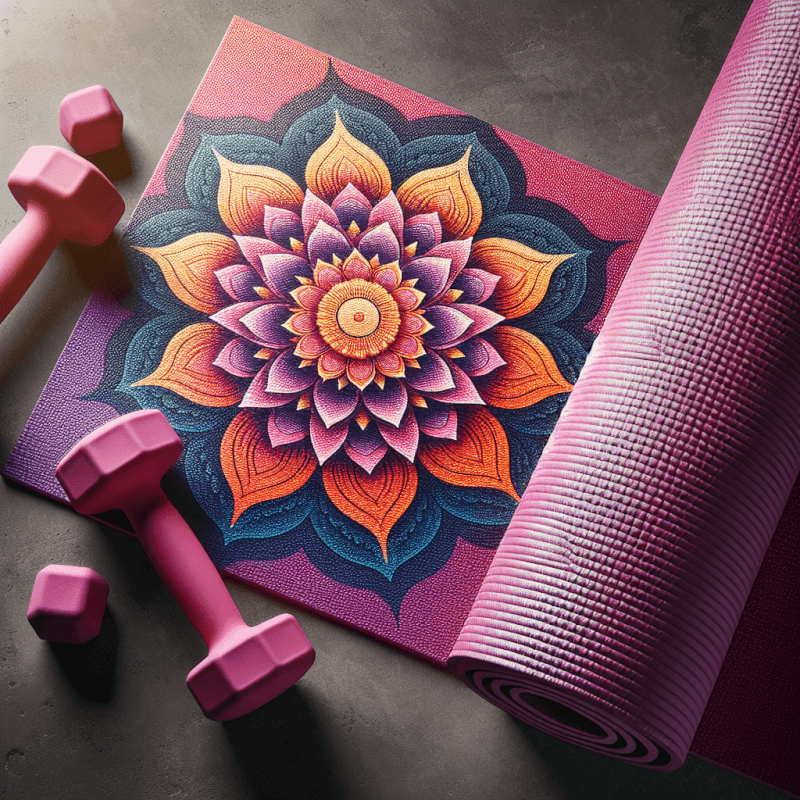Are you over 50 and looking to strengthen your core? Look no further! In this article, we will share an effective workout routine specifically designed for individuals in their 50s and beyond. Strengthening your core is important for overall stability, balance, and posture. Whether you’re a fitness enthusiast or just starting your fitness journey, this workout routine will help you regain and maintain a strong core, enabling you to move with ease and confidence. Let’s get started and discover the benefits of the “Workout Over 50 Core”.

Importance of Core Workouts for Individuals over 50
Maintaining overall health and fitness is crucial for individuals over 50, and one key component of achieving this is through regular core workouts. Core exercises focus on strengthening the muscles in the abdomen, back, and pelvis – the foundation of our body’s strength and stability. By prioritizing core workouts, you can improve your balance and stability, reduce the risk of falls and injuries, and enhance your posture and body alignment.
Maintaining overall health and fitness
As we age, it becomes even more important to prioritize our overall health and fitness. Engaging in regular core workouts helps to strengthen the muscles that support our spine and pelvis, promoting good posture and reducing the risk of back pain. Additionally, a strong core can improve our performance in daily activities, making tasks such as lifting, bending, and reaching easier and safer.
Improving balance and stability
Maintaining good balance and stability is vital as we age, as it reduces the risk of falls and related injuries. Core workouts focus on strengthening the muscles in the abdomen and back, which play a critical role in maintaining balance and stability. By incorporating core exercises into your routine, you can improve your proprioception (awareness of your body’s position in space) and strengthen the muscle groups responsible for maintaining balance.
Reducing the risk of falls and injuries
One of the biggest concerns for individuals over 50 is the risk of falls and injuries. Core workouts help to address this concern by targeting the muscles that stabilize our body. As we age, our muscle mass naturally declines, which can lead to reduced stability and an increased risk of falls. Regular core exercises can counteract this by strengthening the muscles that support our joints and improve our balance, significantly reducing the chances of falls and related injuries.
Enhancing posture and body alignment
Poor posture is a common issue that affects many individuals over 50. It can lead to pain, discomfort, and even further musculoskeletal issues. By incorporating core workouts into your routine, you can strengthen the muscles that support proper spinal alignment, leading to improved posture. A strong core helps to maintain the natural curvature of the spine, reducing the strain on surrounding muscles and promoting better overall body alignment.
Choosing the Right Core Exercises for Individuals over 50
When selecting core exercises for individuals over 50, it is important to consider several factors to ensure safety and effectiveness. Individuals should assess their fitness level and capabilities, take into account any existing medical conditions or injuries, consult with a healthcare professional or fitness trainer, and consider personal preferences and goals.
Assessing individual fitness level and capabilities
Before starting a core workout routine, it is essential to assess your current fitness level and capabilities. This will help you determine which exercises are suitable for your body and avoid overexertion or potential injuries. Consider factors such as strength, flexibility, and balance when gauging your abilities in order to choose exercises that challenge you without overwhelming your body.
Considering any existing medical conditions or injuries
Individuals over 50 may have preexisting medical conditions or injuries that need to be taken into consideration when selecting core exercises. Certain exercises may aggravate these conditions or put unnecessary strain on injured areas. It is crucial to consult with a healthcare professional or physical therapist to ensure that the chosen exercises are safe and aligned with your specific needs.
Consulting with a healthcare professional or fitness trainer
Seeking guidance from a healthcare professional or fitness trainer is highly recommended when choosing core exercises. These professionals can offer personalized advice based on your individual needs, ensure proper form and technique, and modify exercises as necessary. They can also provide modifications for any limitations you may have and help you progress safely and effectively.
Taking into account personal preferences and goals
It is important to choose core exercises that you enjoy and are motivated to incorporate into your routine. By selecting activities that align with your preferences and goals, you are more likely to stay consistent and dedicated to your workout regimen. Whether it’s through group classes, at-home workouts, or outdoor activities, finding exercises that are enjoyable will make the process more sustainable and enjoyable in the long run.
Core Exercises specifically tailored for Individuals over 50
When it comes to core exercises for individuals over 50, it is beneficial to focus on exercises that target multiple muscle groups while minimizing strain on the joints. Here are some core exercises specifically tailored for this age group:
Planks variations
Planks are a versatile exercise that engages multiple muscle groups in the core. To perform a basic plank, start by lying face down on the floor. Place your forearms flat on the ground, elbows under your shoulders, and clasp your hands together. Lift your body off the ground, supporting yourself on your forearms and toes, and engage your core muscles. Hold this position for as long as you can while maintaining proper form. Variations of the plank can include side planks and plank rotations to further challenge the core muscles.
Bridge exercises
Bridge exercises are effective for targeting the muscles in the lower back, hips, and glutes. To perform a bridge, lie on your back with your knees bent and feet flat on the ground. Engage your core, squeeze your glutes, and lift your hips off the ground until your body forms a straight line from your knees to your shoulders. Hold this position for a few seconds, then lower your hips back down. To increase the challenge, you can perform single-leg bridges or add a stability ball to enhance the engagement of the core muscles.
Bird dog exercises
Bird dog exercises are excellent for improving core stability and balance. Begin on all fours, with your hands directly under your shoulders and your knees under your hips. Extend one arm forward while simultaneously extending the opposite leg straight behind you. Keep your back straight and engage your core throughout the movement. Hold this position for a few seconds, then return to the starting position. Repeat the exercise with the opposite arm and leg. Focus on maintaining proper form and stability, rather than speed or quantity.
Seated core exercises
Seated core exercises are beneficial for individuals with limited mobility or those who prefer seated workouts. One example is the seated Russian twist. Sit on the floor with your knees bent and feet flat on the ground. Lean back slightly, engaging your core muscles. Hold a weight or medicine ball in front of you, then rotate your torso from side to side, tapping the weight on the ground on each side. This exercise targets the oblique muscles and helps improve stability and strength in the core.
Standing core exercises
Standing core exercises are excellent for individuals who want to incorporate core workouts into their daily activities or who have difficulty with floor exercises. Standing twists are a great option. Stand with your feet hip-width apart, and extend your arms straight in front of you, parallel to the ground. Rotate your torso to one side, keeping your hips stable, and then rotate to the other side. Engage your core throughout the movement and maintain proper alignment.
Proper Technique and Form for Core Exercises over 50
Maintaining proper technique and form is crucial when performing core exercises, especially for individuals over 50. Here are some essential tips to keep in mind:
Maintaining a neutral spine
It is important to maintain a neutral spine during core exercises to avoid excessive stress or strain on the spine and surrounding muscles. To achieve a neutral spine, align your head, neck, and back in a straight line. Avoid arching or rounding your back, as this can increase the risk of injuries or discomfort.
Engaging the deep abdominal muscles
When performing core exercises, focus on engaging the deep abdominal muscles, such as the transverse abdominis. These muscles act as a natural corset, providing stability and support to the spine. To engage them, imagine pulling your belly button towards your spine and contracting your abdominal muscles.
Avoiding excessive strain on the neck and shoulders
Many core exercises require support from the neck and shoulders, but it is important to avoid excessive strain or tension in these areas. Maintain a relaxed and neutral position for your neck and shoulders, avoiding unnecessary tension. If you feel strain or discomfort, modify the exercise or seek professional guidance.
Breathing properly during exercises
Proper breathing technique is essential during core exercises. Breathe in deeply through your nose and exhale fully through your mouth. Focus on maintaining a steady and controlled breath throughout the exercise, avoiding shallow or irregular breathing. Proper breathing helps to engage the core muscles and provides oxygen to working muscles.
Using proper alignment and posture
Proper alignment and posture are vital for effective and safe core exercises. Maintain good posture by keeping your shoulders down and back, chest lifted, and spine aligned. Avoid excessive rounding or arching of the back and ensure your joints are properly aligned. Good alignment and posture help to maximize the benefits of core exercises and prevent unnecessary strain or injuries.

Incorporating Core Workouts into a Regular Exercise Routine
Incorporating core workouts into your regular exercise routine is essential for individuals over 50. Here are some tips to help you seamlessly integrate core exercises into your existing regimen:
Setting realistic goals and expectations
When incorporating core workouts into your routine, set realistic goals and expectations. Understand that progress may take time, and it’s important to focus on consistency and gradual improvement rather than immediate results. Start with achievable goals and gradually increase the intensity and duration of your core exercises as you become stronger and more confident.
Scheduling regular core workout sessions
To ensure consistency, schedule regular core workout sessions into your weekly routine. Treat them as non-negotiable appointments with yourself. Consistency is key to seeing progress and reaping the benefits of core exercises. Consider finding a time of day that works best for you and stick to it.
Combining core exercises with cardiovascular and strength training
To achieve a well-rounded fitness routine, it is important to combine core exercises with cardiovascular and strength training. Incorporate exercises such as walking, cycling, or swimming to improve cardiovascular health, and add strength training exercises to target other muscle groups in your body. By incorporating a variety of exercises, you can enhance overall fitness and prevent boredom.
Modifying intensity and difficulty levels as needed
Listen to your body and modify the intensity and difficulty levels of your core exercises as needed. It is important to challenge yourself to progress, but it is equally important to avoid overexertion or pushing beyond your limitations. Gradually increase the repetitions, sets, or weights used in your exercises, but always prioritize safety and proper form.
Benefits of Core Workouts beyond Physical Fitness
In addition to the physical benefits, core workouts offer numerous advantages for individuals over 50 that extend beyond physical fitness. Here are some notable benefits:
Improving cognitive function and memory
Engaging in regular core workouts has been shown to improve cognitive function and memory. Exercise increases blood flow to the brain, promoting the growth of new brain cells and enhancing cognitive function. By prioritizing core exercises, you can enhance your mental clarity, focus, and memory skills.
Boosting mood and mental well-being
Physical activity, including core workouts, has a positive impact on mental well-being. Exercise stimulates the release of endorphins, which are the body’s natural feel-good hormones. This can elevate mood, reduce symptoms of anxiety and depression, and boost overall mental well-being. By incorporating core workouts into your routine, you can experience improvements in your emotional state and overall outlook on life.
Promoting better sleep quality
Quality sleep is essential for overall health and well-being. Core workouts can contribute to better sleep quality by reducing stress and anxiety levels, promoting relaxation, and improving overall physical and mental health. By incorporating core exercises into your routine, you may find that you experience more restful and rejuvenating sleep.
Reducing stress and anxiety levels
Stress and anxiety are common experiences for many individuals, especially as they age. Core workouts can provide an effective outlet for releasing stress and anxiety, allowing you to unwind and relax. The focused nature of core exercises can help shift your attention away from daily worries and promote a sense of calmness and tranquility.

Maintaining Consistency and Sustainability in Core Workouts
To maintain consistency and sustainability in your core workouts, consider the following tips:
Starting slowly and gradually increasing intensity
It’s important to start your core workouts at a comfortable intensity level and gradually increase the challenge over time. This allows your body to adapt and progress safely. Pushing too hard too quickly can lead to injury or burnout, potentially hindering your long-term progress.
Listening to the body and avoiding overexertion
Pay attention to how your body feels during and after your core workouts. If you experience pain or excessive fatigue, it may be a sign that you’re overexerting yourself. Give yourself permission to rest and modify exercises as needed. Adapt your routine to match your body’s abilities, and always prioritize your overall well-being.
Seeking support and accountability from fitness buddies or groups
Working out with others can provide a valuable source of support and accountability. Consider finding a fitness buddy or joining a group of like-minded individuals who also prioritize core workouts. This support system can provide motivation, inspiration, and encouragement to stay consistent and committed to your fitness goals.
Finding enjoyable and varied core exercises
To maintain sustainability in your core workouts, it’s important to find exercises that you genuinely enjoy. Explore different core exercises to find what works best for you and keeps you engaged. Variety is key, as it prevents boredom and allows you to challenge different muscle groups within the core.
Guidelines for Safe Core Workouts for Individuals over 50
To ensure safe core workouts, follow these guidelines:
Warming up before the workouts
Always warm up before your core workouts to prepare your body for the exercises ahead. Engage in gentle cardio activities such as walking or jogging, and perform dynamic stretches to increase blood flow and warm up the muscles. Warming up helps reduce the risk of injuries and enhances the effectiveness of your workout.
Using proper equipment and attire
When engaging in core workouts, it is important to use proper equipment and attire. Wear comfortable clothing that allows for a full range of motion and supportive footwear. If needed, use mats or towels to cushion your body during floor exercises and ensure good traction to prevent slipping.
Staying hydrated throughout the session
Stay hydrated throughout your core workouts by drinking water before, during, and after the session. Dehydration can negatively impact performance and increase the risk of muscle cramps and fatigue. Listen to your body’s hydration needs and drink additional water as necessary.
Considering modifications for joint issues or limited mobility
If you have joint issues or limited mobility, it is crucial to consider modifications for your core workouts. Consult with a healthcare professional or fitness trainer who can provide guidance and suggest alternative exercises or variations that are suitable for your specific needs. It is important to prioritize safety and avoid exacerbating any preexisting conditions.

Common Mistakes to Avoid in Core Workouts for Individuals over 50
To maximize the effectiveness and safety of your core workouts, avoid these common mistakes:
Neglecting proper warm-up and cool-down
Failing to warm up adequately before starting your core workouts can increase the risk of injuries. Always allocate time for a thorough warm-up and cool-down to properly prepare and recover your body. This includes performing dynamic stretches, foam rolling, and incorporating gentle movements before and after your workout.
Relying solely on crunches or sit-ups
Crunches and sit-ups are popular core exercises, but relying solely on them can limit the overall effectiveness of your core workouts. It is important to incorporate a variety of exercises that target different muscle groups within the core. This ensures balanced development and reduces the risk of overuse injuries.
Overdoing the exercises
While consistency is important, overdoing core exercises can lead to burnout or injuries. It is important to find the right balance between challenging yourself and giving your body adequate rest and recovery time. Listen to your body’s signals and avoid excessive repetitions or sets that could strain your muscles.
Ignoring caution signs from the body
Your body provides cues when something is not right. Ignoring pain, discomfort, or fatigue during core workouts can lead to injury or worsen existing conditions. If you experience any caution signs, modify the exercise, take a break, or seek professional advice. Your health and safety should always be the top priority.
Tracking Progress and Adapting Core Workouts over Time
Tracking your progress and adapting your core workouts over time is essential for continued growth and improvement. Here are some strategies to help you monitor your progress and make necessary adjustments:
Keeping a workout journal or using fitness apps
Maintaining a workout journal or using fitness apps to track your core workouts can be highly beneficial. This allows you to keep a record of the exercises performed, sets, repetitions, and any modifications made. Tracking your progress helps you identify trends, set realistic goals, and stay motivated.
Gradually increasing repetitions and sets
As you become stronger and more comfortable with certain core exercises, gradually increase the number of repetitions and sets. This progressive overload principle challenges your muscles and promotes continued growth and improvement. Start with small increments and listen to your body’s response, making adjustments as necessary.
Incorporating new exercises for variety
To prevent plateauing or boredom, regularly incorporate new exercises into your core workouts. Experiment with different variations, equipment, or techniques to keep your workouts fresh and exciting. This not only stimulates new muscle groups but also prevents your mind from becoming complacent.
Reassessing fitness goals periodically
Regularly reassessing your fitness goals allows you to evaluate your progress and make any necessary adjustments. As your body adapts and changes, your goals may need to be revised to ensure continued growth. Reflect on your achievements, set new milestones, and strive towards ongoing improvement.
In conclusion, incorporating core workouts into your fitness routine is crucial for individuals over 50 to maintain overall health, improve balance and stability, reduce the risk of falls and injuries, and enhance posture and body alignment. By choosing the right core exercises, maintaining proper technique and form, and consistently engaging in core workouts, individuals over 50 can experience numerous physical and mental benefits. Remember to prioritize safety, listen to your body, and continuously adapt and progress in order to maintain sustainability in your core workouts. Whether you’re a beginner or experienced, core workouts offer a multitude of advantages and should be an integral part of your fitness journey.



